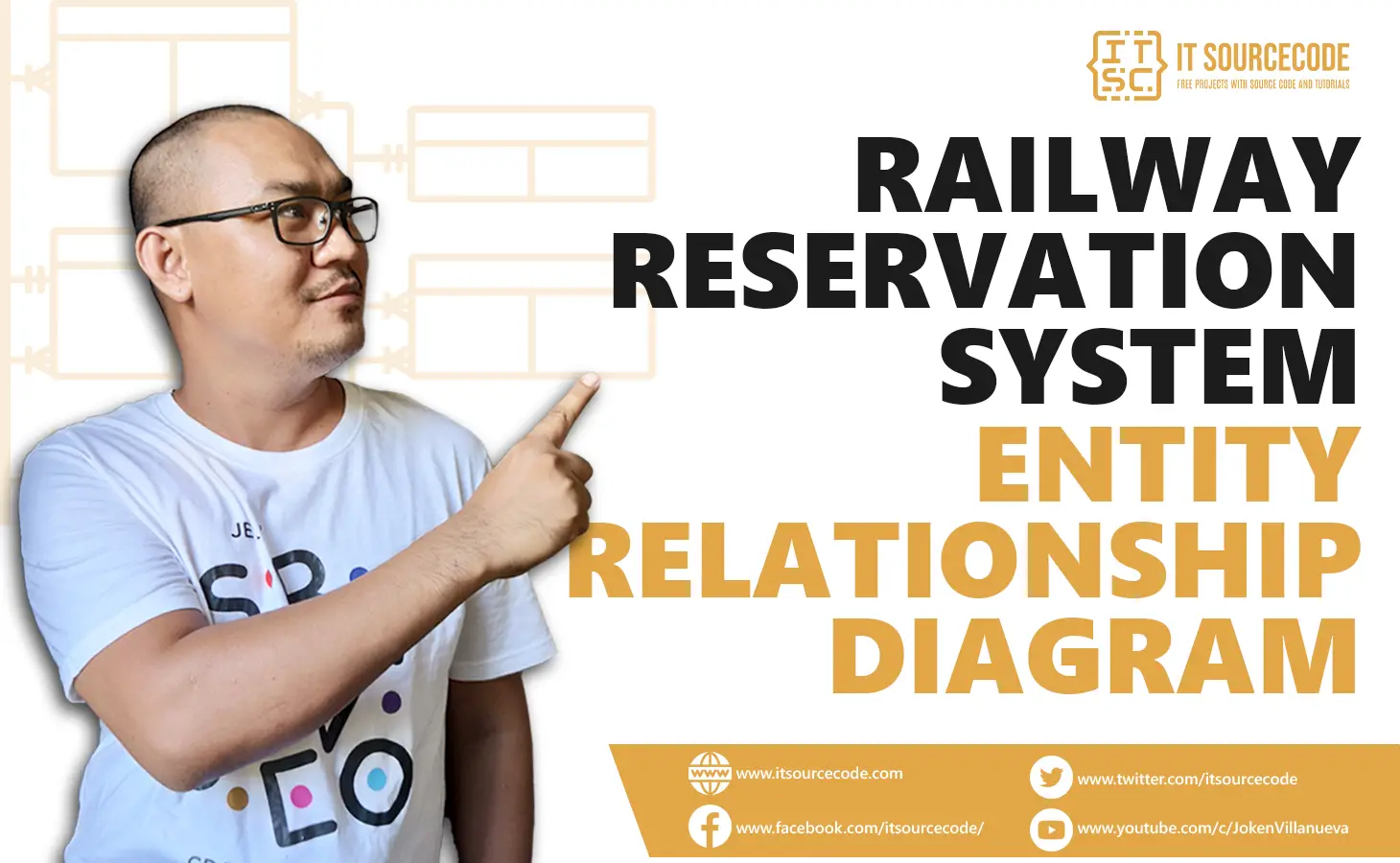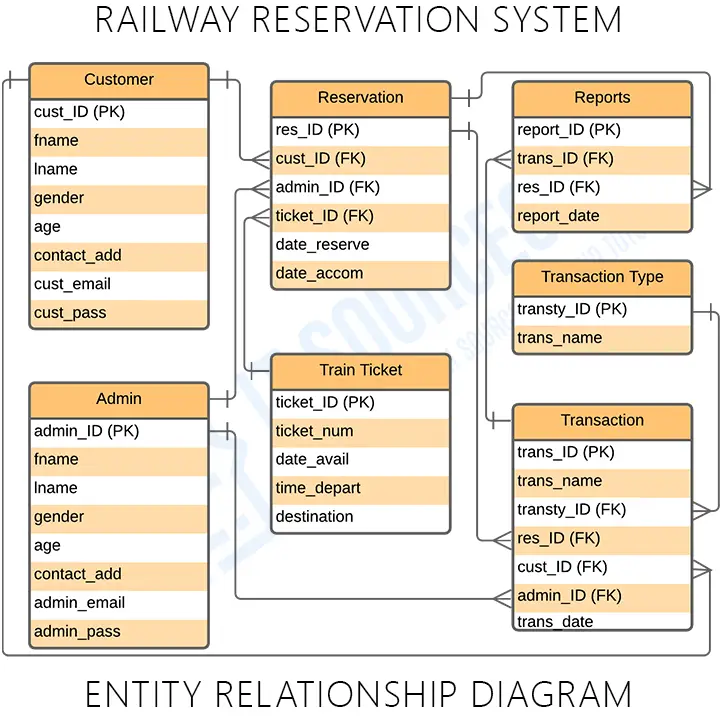The railway reservation system’s ER diagram shows the relationships of the system’s entities that build its database design. This describes the logical structure of the system’s database or data storage. It is done by figuring out the entities in the railway reservation process, their properties, and how they work together.
The railway reservation system database design is sketched out using an ER (entity-relationship) diagram. This sketch becomes the actual basis of the system’s data storage that will serve as both a data destination and a source.
ER Diagram Railway Reservation System: Details
The table shows the overall description of the ER Diagram for the Railway Reservation System. It has a complete overview of the project’s information.
| Name: | Railway Reservation System ER Diagram |
| Abstract: | The railway reservation system ER diagram depicts the relationship between various entities. It can be thought of as a blueprint for your system (project) structure. |
| Diagram: | ER Diagram is also known as Entity Relationship Diagram |
| Tools Used: | Diagraming tools that provide ER diagram symbols. |
| Users: | Train Crews and Passengers |
| Designer: | ITSourceCode.com |
What is Railway Reservation System?
The railway reservation system enables passengers to inquire about available tickets, book tickets, and cancel tickets when needed.
What is the Scope of Railway Reservation System?
The scope of the railway reservation system is to allow passengers to make reservations. any railway station, and they will be updated automatically at all stations.
As a result, the reservation crews or admin of the establishments will have no trouble creating the reservation. Maintaining a global database makes this possible.
Railway Reservation System Features
- Railway Reservation Management: Railway Reservation Management is the main feature of this system. While the ER diagram contains the basic details of the system. The information was made up of the transactions that customers had made and the places that could be reserved.
- Customer Management: This feature plays a big role in the system because it gathers important information about the customers. This information was used to track their transactions and other important matters regarding the system.
- Managing Railway Information: Railway information management was important for the system. because it serves as the basis for the customers as they avail of the reservations offered by the railway. This information was monitored to keep the customers updated.
- Transaction and Reservation Management: Its features will store the reservations made by the customers. as well as the date of the transaction. This will also save the accommodate and keep it up-to-date based on the date the customer wants.
What is the Importance of Railway Reservation System ER Diagram
The importance of the ER diagram for the railway reservation system is to help in modeling its data storage or database. It is the basis of the project’s database foundation for construction.
The railway reservation system entity-relationship diagram (ERD) also aids in defining the data types. They need to be stored, such as their attributes and characteristics.
ER Diagram of Railway Reservation System
The ER diagram for railway reservation system with explanation shows the system’s entity relationships. Each relationship’s entities and their assumed roles
The entity-relationship diagram for the Railway Reservation System Database tables looks like the one above. It had the customer, the admin, the reservation, the train ticket, the transaction, the type of transaction, and the reports.
The tables are made to meet the required specification of the system. To provide much more specific details of each entity within the system.
How Railway Reservation System Database Design works?
This railway reservation system database design was made based on managing reservation requirements. The system can encode customers’ requests regarding railway reservations.
Its admin can access the customers’ status and information. It can also handle and update data in reservations and customer transactions.
Railway Reservation System ER Diagram Tables
These tables below provide the complete database table details, such as field names, descriptions, data types, and character lengths. Each of these tables represents the characteristics and attributes of data storage.
The field column presents the names of each database’s attributes. The description column gives the complete idea of each attribute. And the type column is their data type, and the length is for their character lengths.
Table Name: Customer
| Field | Description | Type | Length |
| stud_ID (PK) | Customer ID | Int | 11 |
| fname | Customer First Name | Varchar | 255 |
| lname | Customer Last Name | Varchar | 255 |
| gender | Customer Gender | Int | 11 |
| age | Customer Age | Int | 11 |
| contact_add | Contact Address | Int | 11 |
| cust_email | Customer Email | Varchar | 255 |
| cust_pass | Customer Password | Varchar | 255 |
Table Name: Admin
| Field | Description | Type | Length |
| admin_ID (PK) | Admin ID | Int | 11 |
| fname | Admin First Name | Varchar | 255 |
| lname | Admin Last Name | Varchar | 255 |
| gender | Admin Gender | Int | 11 |
| age | Admin Age | Int | 11 |
| contact_add | Contact Address | Int | 11 |
| admin_email | Admin Email | Varchar | 255 |
| admin_pass | Admin Password | Varchar | 255 |
Table Name: Train Ticket
| Field | Description | Type | Length |
| ticket_ID (PK) | Ticket ID | Int | 11 |
| ticket_num | Ticket Number | Int | 11 |
| date_avail | Date Available | Date | |
| date_flight | Date of Flight | Date | |
| time_depart | Departure Time | Time | |
| time_land | Landing Time | Time | |
| destination | Destination | Varchar | 30 |
Table Name: Reservation
| Field | Description | Type | Length |
| res_ID (PK) | Reservation ID | Int | 11 |
| cust_ID (FK) | Customer ID | Int | 11 |
| admin_ID (FK) | Admin ID | Int | 11 |
| ticket_ID (FK) | Ticket ID | Int | 11 |
| date_reserve | Date Reservation | Date | |
| date_accom | Date of Accommodation | Date |
Table Name: Transaction
| Field | Description | Type | Length |
| trans_ID (PK) | Transaction ID | Int | 11 |
| trans_name | Transaction Name | Varchar | 30 |
| borrowing_ID (FK) | Subject ID | Int | 11 |
| stud_ID (FK) | Student ID | Int | 11 |
| trans_date | Date of Transaction | Date |
Table Name: Transaction Type
| Field | Description | Type | Length |
| transty_ID (PK) | Transaction Type ID | Int | 11 |
| trans_name | Transaction Type | Varchar | 30 |
Table Name: Reports
| Field | Description | Type | Length |
| report_ID (PK) | Report ID | Int | 11 |
| trans_ID (FK) | Transaction ID | Int | 11 |
| res_ID (FK) | Reservation ID | Int | 11 |
| report_date | Report Date | Date |
The tables given will be the basis for developers on how they will do the railway reservation system database design. They have the complete description of the database, and they will put this into the program.
The data storage is the same as the names given to each of the tables. Create a database with the attributes given as well as the value of each attribute.
Railway Reservation System ER Diagram [PDF]
The Railway Reservation System ER Diagram PDF provides the information explaining the concepts of the project database. You may apply this information to your capstone project. You can also use it directly or modify its content depending on your project’s requirements.
How to create an Entity-Relationship (ER) Diagram
Time needed: 5 minutes
Steps in building the ER Diagram for Railway Reservation System with Cardinality Ratio.
- Step 1: Become acquainted with the ER Diagram (Entity Relationship Diagram). Symbols and Cardinality
The Entity Relationship Diagram shows the structure of data types in a project. It uses symbols to clarify its parts and relationships. Their symbols and applications must be familiar before you build the ER Diagram.
ER Diagram Symbols:
Fields are the parts of a table that define the entity’s characteristics. In the database that the ERD models, attributes are commonly thought of as rows.
Keys are a technique to categorize data quality. It is used to organize ER diagrams and assist users in modeling their databases to ensure that they are efficient. This is also used to connect different tables in a database.
A primary key identifies a single entity instance, which means a unique attribute or set of attributes.
A foreign key is produced when data attributes have one too many relationships with other entities. - Step 2: Complete the entities that will be included.
Start designing your ER Diagram by finalizing the entities that must be included in your railway reservation system. This entity is represented by a rectangle. You must leave enough space for them in future phases so that they can be incorporated into your design.
- Step 3: Add the attributes of each entity
After finalizing the entities, think about the qualities you’ll need to characterize each entity. The details of the various entities outlined in a conceptual ER diagram are supplied as attributes. All of these are examples of attributes. Multivalued attributes can be assigned to several values.
- Step 4: Describe the relationships (cardinality) between entities and attributes
To plot relationships between the ERD, you will need the entities, their attributes, and relationships. You will base the data structure on the evaluated information to have the exact entity relationship diagram.
Conclusion:
The ER (entity-relationship) diagram is only one of the diagrams used to design and develop the railway reservation system. Each of the diagrams you design and create will help you present your ideas and impart your abilities.
Creating the ER diagram will help you perceive the back end. The software that will hold all the data that’ll enter and exit the system. To learn more about the ER Diagrams and more, check out the related and recommended articles below.
Related Articles:
- Airline Reservation System ER Diagram
- College Library Management System ER Diagram
- College Management System ER Diagram
- School Management System ER Diagram
- University Management System ER Diagram
Recommended Articles:
- Component Diagram for Railway Reservation System
- Deployment Diagram for Railway Reservation System
- Online Railway Reservation System Class Diagram
- Railway Reservation System Sequence Diagram
- Railway Reservation System Activity Diagram
Inquiries
If you have inquiries or suggestions about the Railway Reservation System ER Diagram, just leave us your comments below. We would be glad to know to concerns and suggestions and be part of your learning.
Keep us updated and Good day!


